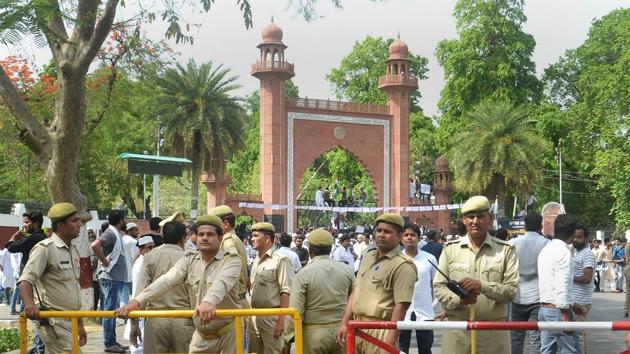Students can be emissaries of Hindu-Muslim unity
I do not know what whether the AMU and the BHU actually do have regular interactions. I suspect not. In that case, such interactions should be encouraged and furthered by the faculty and students, with groups having any political affiliation (right, left, or centre) being absolutely kept out.
In January 1942, Mahatma Gandhi was invited to speak at the Silver Jubilee Convocation of the Banaras Hindu University (BHU). He knew both the city and the university well. His first major speech after returning to India was delivered at the founding ceremonies of BHU, back in February 1916, when he famously asked the Maharajas present to shed their ostentatious lifestyles. “There is no salvation for India”, he told the grandees at the ceremony, “unless you strip yourself of this jewelry and hold it in trust for your countrymen in India”. “There can be no spirit of self-government about us,” he added, “if we take away or allow others to take away from the peasants almost the whole of the results of their labour.”

Gandhi’s 1942 visit to BHU was at the invitation of the university’s vice-chancellor, the renowned philosopher and future president of India, Sarvepalli Radhakrishnan. The speaker before him had boasted about the university’s engineering departments. Gandhi said that was all well and good, but the university’s real contribution to nation-building would lie in other spheres. He urged the BHU to have close and continuous interactions with another great university, which however carried “Muslim” rather than “Hindu” in its name. As Gandhi asked of his audience: “Have you been able to attract to your University youths from Aligarh? Have you been able to identify with them? That, I think, should be your special work, the special contribution of your University. Money has come in, and more will come in if God keeps Malaviya ji in our midst for a few more years. But no amount of money will achieve the miracle I want—I mean a heart-unity between Hindus and Muslims.”
I was reminded of these words when reading of the recent happenings at the Aligarh Muslim University (AMU). As other commentators have pointed out, debates on whose portrait can or cannot hang inside the walls of the campus are legitimate; so long as they are conducted by the teachers and students of the university in question. In this case, however, it was vandals from outside, egged on by right-wing politicians, who invaded AMU and caused an ugly scene and some violence too.
The AMU has produced many fine historians, sociologists and legal scholars. It is less known that it has also had a robust tradition of science education. It was the AMU which gave us Obaid Siddiqui, who nurtured our best (and arguably only world-class) scientific institute, the National Centre for Biological Research. Of all the Indian scholars in any field I have met in my lifetime, Siddiqui was the one I most admired, for his character, intelligence, and humanity, and for what he did for our country.
I started my own professional career 30 years ago. In that time I have had many junior colleagues myself, dozens of young students who have assisted or advised me in the writing of my books and essays. Of all these research assistants, the best and most capable was a proud graduate of the AMU. But I must not name him in public, because he is a shy man, and would be embarrassed if I did. But I should say one thing about him; that he is a Hindu.
I was glad to see that when the mischief-making outsiders came crashing into the gates of the AMU, Hindu students were as determined to protect the autonomy of their university as those who were raised Muslim. Likewise, while the best known professors, and the majority of the students, of the BHU may have been Hindus, that university must also have had many Muslims who studied there and went on to build successful careers, and who retain a deep attachment to their alma mater.
That said, it remains the case that these two universities are still seen as essentially belonging to one community alone. That may be because they flag their respective religious identity in their very names; and because the student composition of AMU has a majority (or at least plurality) of Muslims and that of BHU a majority of Hindus.
I do not know what whether the AMU and the BHU actually do have regular interactions. I suspect not. In that case, such interactions should be encouraged and furthered by the faculty and students, with groups having any political affiliation (right, left, or centre) being absolutely kept out.
I have also recalled Gandhi’s 1942 BHU address in my recent visits to the most-troubled state of our Union. In 2015 I spoke at the Kashmir University, in Srinagar; two years later, I spoke at the Jammu University, in Jammu. I enjoyed both visits enormously, not least because in each case I was staying at the university guest house and so my conversations with students and faculty began at breakfast and continued well into the night. Both institutions had done this Tamil from Bengaluru the immense honour of hosting and caring for him. However, each had little to do with the other. The students and faculty of Jammu University were absolutely cut off from the activities of the Kashmir University; and the reverse was also the case. The odd professor in both places recognised that this was a problem; but there seemed to be no efforts on to resolve it.
I am not saying that such interactions on their own can lead to the “heart-unity between Hindus and Muslims” that Mahatma Gandhi lived and died for. But surely having young minds reared in one particular institutional context encounter other young minds reared in another, can help in breaking down bridges and overcoming prejudices.
Ramachandra Guha’s books include Gandhi Before India
The views expressed are personal






